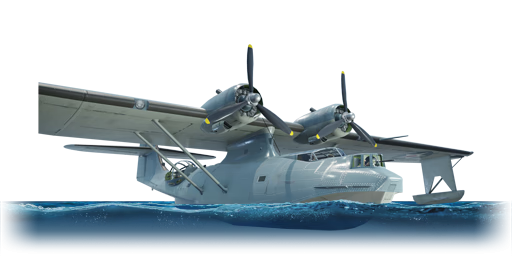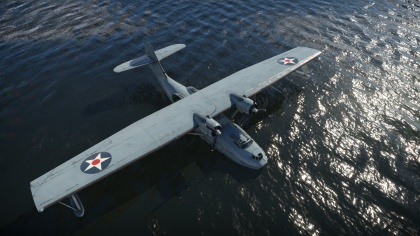Difference between revisions of "PBY-5 Catalina"
(→History) (Tag: Visual edit) |
(Changed History, added an Image of the catalina in game with a custom skin and link to it with credit to the author, changed the sources with the sources I used to learn the history) (Tag: Visual edit) |
||
| Line 245: | Line 245: | ||
== Media == | == Media == | ||
| − | + | ||
| + | [[File:Catalina Kiwi Skin made by Aotea - https---bit.ly-3bXp3NI.jpg|alt=Catalina Kiwi Skin made by Aotea - https://bit.ly/3bXp3NI|thumb|This is NZ4020 -a PBY-5 operated by 6 Squadron RNZAFShe was brought on charge at Fiji in October 1943, and given the code XX-W. | ||
| + | |||
| + | While on operational duty she was nicknamed "The Wandering Witch" Unfortunately when she visiting New Zealand in May 1945 she stalled on landing, and had to be towed to her mooring by crash boat. There were no fatalities but the Witch herself was written off due to damage sustained.]] | ||
== See also == | == See also == | ||
| Line 255: | Line 258: | ||
== External links == | == External links == | ||
| − | |||
| − | * | + | * https://www.history.navy.mil/content/history/museums/nmusn/explore/photography/wwii/wwii-atlantic/battle-of-the-atlantic/aviation/pby-5a.html |
| − | * | + | * https://en.wikipedia.org/wiki/Consolidated_PBY_Catalina |
| − | * | + | * https://airandspace.si.edu/collection-objects/consolidated-pby-5-catalina/nasm_A19730277000 |
{{AirManufacturer Consolidated}} | {{AirManufacturer Consolidated}} | ||
{{USA bombers}} | {{USA bombers}} | ||
Revision as of 22:00, 6 April 2020
Contents
| This page is about the American bomber PBY-5 Catalina. For other versions, see PBY-5 (Family). |
Description
The PBY-5 Catalina is a rank I American bomber
with a battle rating of 1.3 (AB/RB) and 2.0 (SB). It has been in the game since the start of the Open Beta Test prior to Update 1.27.
General info
Flight performance
Describe how the aircraft behaves in the air. Speed, manoeuvrability, acceleration and allowable loads - these are the most important characteristics of the vehicle.
| Characteristics | |||||||
|---|---|---|---|---|---|---|---|
| Stock | |||||||
| Max Speed (km/h at 2,135 m) |
Max altitude (meters) |
Turn time (seconds) |
Rate of climb (meters/second) |
Take-off run (meters) | |||
| AB | RB | AB | RB | AB | RB | ||
| 260 | 252 | 4480 | 29.0 | 29.8 | 2.3 | 2.3 | 535 |
| Upgraded | |||||||
| Max Speed (km/h at 2,135 m) |
Max altitude (meters) |
Turn time (seconds) |
Rate of climb (meters/second) |
Take-off run (meters) | |||
| AB | RB | AB | RB | AB | RB | ||
| 320 | 288 | 4480 | 27.1 | 28.0 | 9.2 | 4.8 | 535 |
Details
| Features | ||||
|---|---|---|---|---|
| Combat flaps | Take-off flaps | Landing flaps | Air brakes | Arrestor gear |
| X | X | X | X | X |
| Limits | ||||
|---|---|---|---|---|
| Wing-break speed (km/h) |
Gear limit (km/h) |
Combat flaps (km/h) |
Max Static G | |
| + | - | |||
| 520 | ~2 | ~2 | ||
| Optimal velocities | |||
|---|---|---|---|
| Ailerons (km/h) |
Rudder (km/h) |
Elevators (km/h) |
Radiator (km/h) |
| < 220 | < 220 | < 230 | > 312 |
| Compressor (RB/SB) | ||
|---|---|---|
| Setting 1 | ||
| Optimal altitude | 100% Engine power | WEP Engine power |
| 1,886 m | 1,050 hp | 1,491 hp |
Survivability and armour
- 9.5 mm steel pilot seats
- 6.35 mm steel behind tail gunner
- 6.35 mm and 4.7 mm steel plates inside the structural pylon
- Critical components located at front of aircraft (fuel, pilot, engine, controls)
- 2 self-sealing fuel tanks in the wings
Armaments
Suspended armament
The PBY-5 Catalina can be outfitted with the following ordnance:
- 16 x 100 lb AN-M30A1 bombs (1,600 lb total)
- 4 x 500 lb AN-M64A1 bombs (2,000 lb total)
- 4 x 1,000 lb AN-M65A1 bombs (4,000 lb total)
- 2 x Mk.13 torpedoes
- 2 x Mk.13/44 torpedoes
Defensive armament
The PBY-5 Catalina is defended by:
- 1 x 12.7 mm Browning M2 machine gun, 2 x beam turrets (478 rpg)
- 1 x 7.62 mm Browning machine gun, nose turret (1,000 rpg)
- 1 x 7.62 mm Browning machine gun, ventral turret (500 rpg)
Usage in battles
Although technically a medium bomber, the PBY-5's strategies are much like that of heavy bombers in higher tiers such as the B-17. It is best to fly high, as flying low will make you an easy target for fighters and AA. The best tactic for fending off enemy fighters is to use the rudders to direct one of the side gunners towards the attacking plane. It is also smart to use the guns manually in this situation, as the AI is often very inaccurate and will refuse to fire beyond a certain distance. In the worst case scenarios, a dive can be used to greatly increase the plane's speed to get to attack a ground target before a pursuing enemy fighter shoots it down.
The plane is quite unmanageable, and its wings are very weak, being able to snap just by turning just a little too tight at higher speeds in a Realistic Battle. Its lack of landing gear means that extra caution should be taken when landing, as it must land on its belly to rearm in a Realistic Battle.
Although the PBY-5 Catalina is slow and clunky, it offers a heavy payload that is sure to be a game changer if used properly. One of the bomber's biggest cons is its lack of landing gear, although it can still belly land onto airstrips. It also has a very good defensive armament for its tier, which can occasionally be a saviour against an enemy fighter.
The armament on the PBY-5 Catalina is what makes up for its clunky movement. The plane is capable of carrying a heavy payload of bombs or torpedos and has defensive gunners on all sides. The two side gunners have .50 calibre machine guns,making it more than capable of destroying enemy aircraft that stay within their range.
Manual Engine Control
| MEC elements | ||||||
|---|---|---|---|---|---|---|
| Mixer | Pitch | Radiator | Supercharger | Turbocharger | ||
| Oil | Water | Type | ||||
| Not controllable | Controllable Auto control available |
Controllable Not auto controlled |
Controllable Not auto controlled |
Separate | Not controllable 1 gear |
Not controllable |
Modules
| Tier | Flight performance | Survivability | Weaponry | ||
|---|---|---|---|---|---|
| I | Fuselage repair | Radiator | Turret 7 mm | MBC-5 | |
| II | Compressor | Airframe | New 7 mm MGs (turret) | LTC-5 | |
| III | Wings repair | Engine | Turret 12 mm | Improved torpedo | |
| IV | Engine injection | Cover | New 12 mm MGs (turret) | LBC-5 | |
Pros and cons
Pros:
- Good payload
- Good rear defensive armament with a high coverage angle
- Durable
- Can capture points (in Naval)
Cons:
- Very bad at climbing
- Slow top speed
- No wheels for landing on hard surfaces (hydroplane only)
History
Produced from the 1930's to the 1940's by Consolidated Aircraft it was one of the most widely produced (a total of 3,282 were built) and used seaplanes of World War II, Serving in every branch of the United States Armed Forces. During the war they were used for anti-submarine warfare, patrol bombing, convoy escort, Search and Rescue missions, and cargo transport. Before the start of the war many aviation critics and engineers considered the flying boat obsolete due to its slow speed, its max being 189, but despite this its 2 big selling factors were its amazing range about 2,990 miles (4811.939 Kilometers) and durability. Earlier versions of the Catalina were true flying boats and could only land on water, pilots could land on water and beach the aircraft if necessary but in 1939 Consolidated first flew the PBY-5a with a retractable landing gear mounted directly between the 2 support beams underneath the wings. With this new ability to land on land it allowed the Catalina to become ERS or Emergency Rescue Squadrons and be able to pick up bomber crews from downed a B-29-A-BN who weren't able to land due to damage suffered from a bombing run. After the war ended a lot of Catalina's were put to civilian use whether it be casual flying or for something like firefighting. It lives on in game the same as it did in battle, being very slow but carrying a great number of armaments which represents its many roles it played in World War II and at its Battle Rating able to take a great number of hits before finally getting shot down.
In-game description
There were two firms competing for the naval patrol bomber supply contract: Consolidated and Douglas. Although both prototypes met the U. S. Navy demands, on June 29, 1935 the contract was awarded to Consolidated due to lower production costs (the firm projected the cost of one aircraft to be $90,000, while their colleagues from Douglas quoted $110,000).
Manufacturing orders for PBY-2 and PBY-3 were concluded before the delivery of the first production aircraft from the previous series (accordingly, PBY-1 and PBY-2). However, when the order for PBY-4 was signed toward the end of 1937, which consisted of just 33 boat planes (this was the smallest of the PBY series), by the time production began the model was already considered outdated and likely to be the last of the series (when PBY-5 was commissioned, development of the next series of hydroplanes set to replace PBY was already underway).
That's exactly what would have happened if the Germans hadn't attacked Poland on September 1, 1939, thus greatly increasing the demand for patrol aircraft. Great Britain immediately ordered 106 units of PBY-5 (dubbed Catalina I), while the USA ordered 200 units of PBY-5 (which were later officially named Catalina as well). Other countries to place orders for PBY-5 included Australia, Canada, Holland and France.
The main difference between the PBY-5 and its predecessors included a higher-powered Pratt & Whitney R-1830-82 engine (operating at 1200 hp), a redesigned tail unit, and waist gun blisters instead of flat windows.
The PBY was used as a bomber and torpedo carrier, and was often utilized in night operations, as well as on patrol, rescue and transportation missions.
PBY Catalina was the most massive of the hydroplanes. Out of 3300 planes spanning all modifications, more than 100 are operational to this day, redesigned for civil purposes.
Media
See also
External links
- https://www.history.navy.mil/content/history/museums/nmusn/explore/photography/wwii/wwii-atlantic/battle-of-the-atlantic/aviation/pby-5a.html
- https://en.wikipedia.org/wiki/Consolidated_PBY_Catalina
- https://airandspace.si.edu/collection-objects/consolidated-pby-5-catalina/nasm_A19730277000
| Consolidated Aircraft Corporation | |
|---|---|
| Bombers | PBY-5 Catalina · PBY-5A Catalina |
| PB4Y-2 | |
| B-24D-25-CO | |
| Export | ▄Catalina Mk IIIa · ▂PBY-5A Catalina · ▄PBY-5A Late · ␗PB4Y-2 · ▄PB4Y-2 |
| USA bombers | |
|---|---|
| Dive | SB2U-2 · SB2U-3 · SBD-3 · SB2C-1C · SB2C-4 |
| Torpedo | TBD-1 · PBY-5 Catalina · PBY-5A Catalina · TBF-1C · BTD-1 |
| Medium | B-10B · B-18A · B-34 · PV-2D · B-25J-1 · B-25J-20 · A-26C-45 · A-26C-45DT · B-26B |
| Heavy | B-17E · B-17E/L · B-17G-60-VE · PB4Y-2 · B-24D-25-CO · B-29A-BN |
| Hydroplanes | OS2U-1 · OS2U-3 · PBM-1 "Mariner" · PBM-3 "Mariner" |





